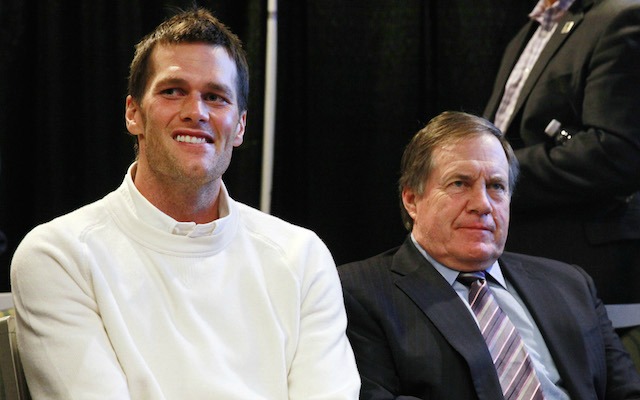Equipment-related cheating in professional sports
May 22, 2015
Creative Commons
New England Patriots quarterback Tom Brady and New England Patriots head coach Bill Belichick during the Super Bowl XLIX-Winning Head Coach and MVP Press Conference. The two fended many questions regarding Deflategate.
During the 2015 American Football Conference (AFC) Championship game on Jan. 18, 2015, eleven of the twelve New England Patriot footballs were inflated below the minimum of 12.5 PSI, enabling easier grip for both quarterback Tom Brady and wide receivers. Opponents Indianapolis Colts competed with footballs inflated to standard pressure, and the Patriots, who went on to win the Super Bowl, were accused of having an unfair advantage. After conducting intensive investigations, the National Football League (NFL) has suspended Tom Brady for four games without pay, fined the New England Patriots $1 million and revoked two of the team’s draft picks in 2016 and 2017.
This scandal, known as “Deflategate,” sparked nationwide controversy. Mountain View Volleyball Club’s 13-Red team’s head coach, Colleen Carey, says that the New England Patriots should be held responsible for the scandal.
“There’s a lot of things about Tom Brady wanting to keep the balls on the lower end [of the news] and so maybe [“Deflategate”] was actually feasible,” she said. “Maybe it wasn’t Tom Brady that knew, but somebody had to know — it was such a big discrepancy [in pressure].”
However, many believe that “Deflategate” has received excessive media coverage.
“In the football world, it’s about the equivalent of wearing seven-eighths inch cleats when you’re supposed to wear three-quarter inch cleats,” Upper School Strength and Conditioning Coordinator Ron Forbes said. Before coming to Harker, Forbes was the coordinator of strength and conditioning at the University of Florida and the director of sports performance at Stanford for seven years.
“I just think that was something to stir up controversy. Basketball players may not be so sensitive that they can pick up a ball and [say], ‘There’s exactly 13 pounds of pressure in here.’ But, as soon as they start to dribble it, they know it’s either under-inflated or over-inflated. Well, it’s kind of the same with a quarterback with a football. You pick it up and throw it, [and] you know it’s under-inflated or over-inflated. Under-inflating a football allows the quarterback to grip it better and throw it better, and that happens every week at the collegiate level and the NFL level.”
What provokes a team as successful as the 4-time Super Bowl Champion Patriots, who were accused of videotaping the New York Jets’ play calls during a 2007 game, to rely on illicit tactics to win? Forbes believes that one of the reasons lies in the financial pressure that professional organizations place on their athletes.
According to a 2014 report from Business Insider, the average annual salaries of professional athletes in the National Basketball Association (NBA), Major League Baseball (MLB), National Hockey League (NHL) and National Football League (NFL) are $4.5, $3.9, $2.4 and $2.0 million, respectively.
“At that level, I think you’re asking a question that has more to do with financial success and wealth than about winning. LeBron James was 18 when he graduated from high school,” said Forbes. “I would like to know how many 18-year-olds would act responsibly if you put $50 million in cash in [their] hands and then watched them for the next two or three years. The athletic population is faced with tremendous opportunity to make poor decisions at a very young age.”
Professional athletes have an influence on the actions of aspiring athletes. Those who look up to the players and coaches hope to one day stand in their shoes.
University of San Diego Sports Psychology Consultant Paul Ashbrook reflected on the resonating effect that well-known athletes have upon children.
“Professional athletes often times don’t want to acknowledge they are role models. The thing is, whether they want to be role models or not, they are,” he said in a phone interview. “When most kids are growing up, they say ‘I wanna be like Michael Jordan, or Tom Brady,’ or whomever, so you’re naturally going to be drawn to these people, whether the athletes agree with it or not.”
